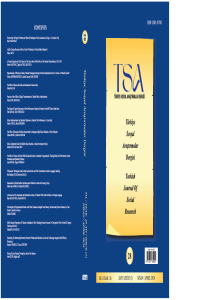Öz
Bu çalışmanın amacı ortaokul öğrencilerinin okula uyum düzeylerini belirlemek amacıyla bir ölçme aracı geliştirmektir. Ölçek geliştirme sürecinde ilk olarak okula uyum kavramı ve olası bileşenleri araştırılmış, kavramın sosyal uyum ve akademik uyum olmak üzere temel iki bileşenden oluştuğu görüldüğünden okula uyum bu iki boyut temelinde kavramsallaştırılmıştır. Bu kavramsallaştırmaya göre araştırmacılar tarafından yazılan maddelerle uzman görüşüne başvurularak 29 maddelik beşli likert tipte yanıtlanan bir form oluşturulmuştur. Gerekli izinlerin alınmasının ardından 3 farklı ortaokulda öğrenim gören toplam 311 öğrenciye 29 maddelik form uygulanarak açımlayıcı faktör analizi yapılmış, ölçeğin Eigen değeri 1’den büyük akademik uyum (9 madde) ve sosyal uyum (9 madde) adında 2 faktörden oluştuğu tespit edilmiştir. Yapılan paralel analiz ve yamaç birikinti grafiği de iki faktörlü yapıyı desteklemiştir. Açımlayıcı faktör analizi sonrasında elde edilen 18 maddelik ölçek formu, 4 farklı ortaokulda öğrenim görmekte olan toplam 303 öğrenciye uygulanarak doğrulayıcı faktör analizi yapılmış ve iki faktörlü yapının iyi düzeyde model-veri uyumu gösterdiği bulunmuştur (x^2=232.591, df=134, RMESA [90%]= ,049 [,038- ,060], CFI=,938; TLI=,929; SRMR=,052). Cronbach alfa iç tutarlık katsayıları açımlayıcı faktör analizi aşamasında akademik uyum için ,87; sosyal uyum için ,86 ve ölçeğin tamamı için ,91 olarak; doğrulayıcı faktör analizi aşamasında akademik uyum için ,88; sosyal uyum için ,86 ve ölçeğin tümü için ,90 olarak tespit edilmiştir. Bir ölçüte dayalı geçerlik kapsamında yapılan analizlerde, beklendiği üzere, okula uyum ile okul tükenmişliği arasında negatif; okul başarısı arasında ise pozitif ilişkilerin olduğu gözlenmiştir. Elde edilen bulgular, geliştirilen ölçeğin ortaokul öğrencilerinin okula uyum düzeylerini ölçmede kullanılabileceğine ilişkin psikometrik açıdan tatmin edici sonuçlar sunmaktadır.
Anahtar Kelimeler
Kaynakça
- Adelson, J. L. ve McCoach, D. B. (2010). Measuring the mathematical attitudes of elementary students: The effects of a 4-point or 5-point likert-type scale. Educational and Psychological Measurement, 70(5), 796–807. https://doi.org/10.1177/0013164410366694
Öz
The aim of this study was to develop a scale to measure the level of school adjustment among middle school students. During the scale development process, the concept of school adjustment and its potential components were thoroughly researched. It was observed that the concept could be conceptualized into two fundamental dimensions: social adjustment and academic adjustment. Based on this conceptualization, a 29-item form was created by the researchers, and expert opinions were sought. After obtaining the necessary permissions, the form was administered to a total of 311 students from three different middle schools, and an exploratory factor analysis was conducted. The analysis revealed that the scale consisted of two factors, namely academic adjustment (9 items) and social adjustment (9 items), with eigenvalues exceeding 1. The two-factor structure was further supported by parallel analysis and scree plot. Subsequently, the 18-item scale obtained from the exploratory factor analysis was administered to 303 students from four different middle schools for confirmatory factor analysis, which demonstrated a good fit for the two-factor structure (x^2=232.591, df=134, RMSEA [90%]= ,049 [,038- ,060], CFI=,938; TLI=,929; SRMR=,052). Internal consistency, as measured by Cronbach's alpha, was found to be .87 for academic adjustment, .86 for social adjustment, and .91 for the entire scale in the first sample; and .88 for academic adjustment, .86 for social adjustment, and .90 for the entire scale in the second sample. Furthermore, the analysis conducted to assess criterion-based validity revealed expected negative correlations between school adjustment and school burnout, as well as positive correlations with school achievement. These findings provide satisfactory psychometric results, indicating that the developed scale can be effectively utilized to measure the school adjustment levels of middle school students.
Anahtar Kelimeler
Kaynakça
- Adelson, J. L. ve McCoach, D. B. (2010). Measuring the mathematical attitudes of elementary students: The effects of a 4-point or 5-point likert-type scale. Educational and Psychological Measurement, 70(5), 796–807. https://doi.org/10.1177/0013164410366694
Ayrıntılar
| Birincil Dil | Türkçe |
|---|---|
| Konular | Bilgi Sistemleri (Diğer) |
| Bölüm | Makaleler |
| Yazarlar | |
| Yayımlanma Tarihi | 7 Nisan 2024 |
| Gönderilme Tarihi | 9 Ağustos 2023 |
| Yayımlandığı Sayı | Yıl 2024 Cilt: 28 Sayı: 1 |

